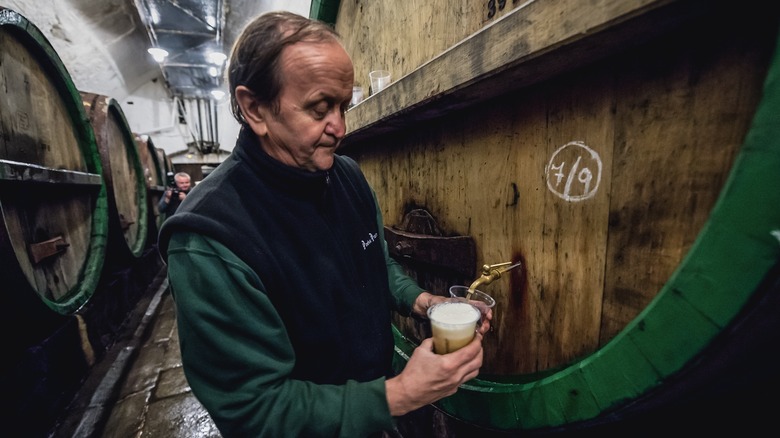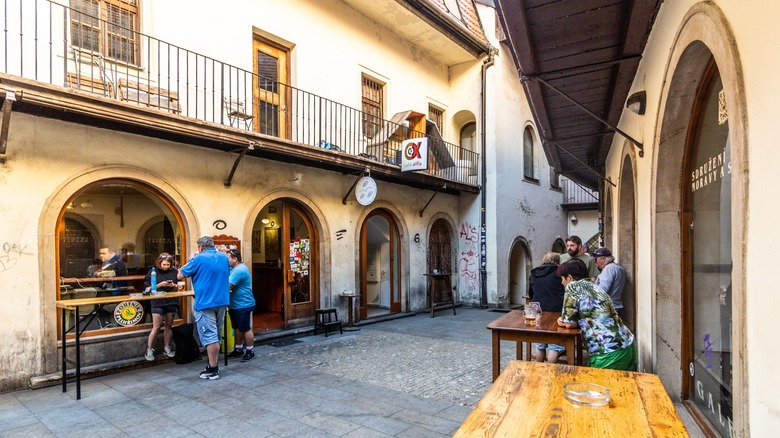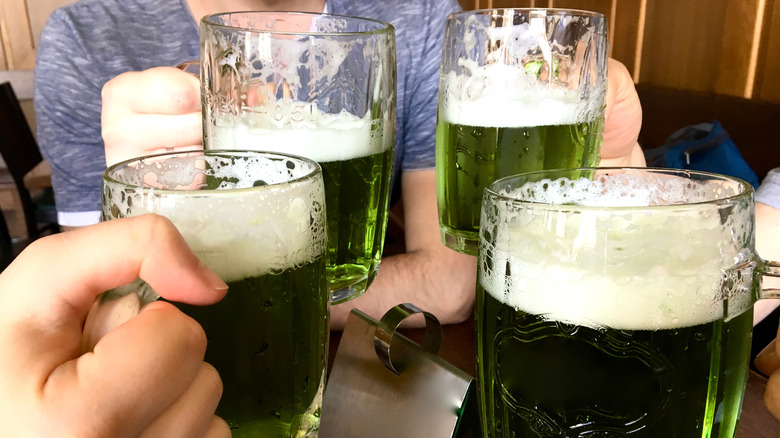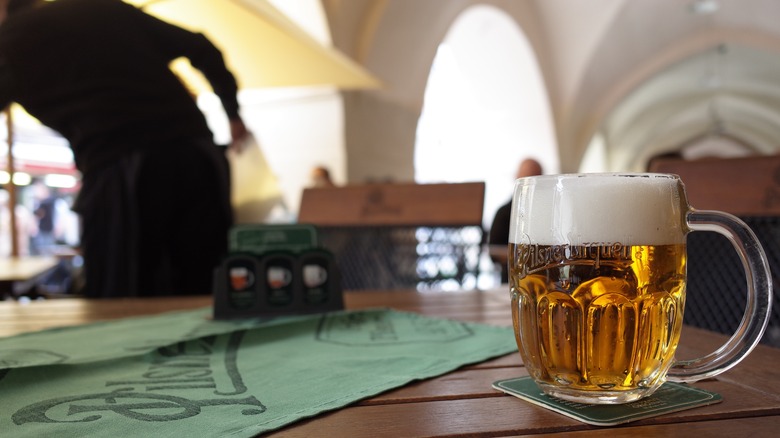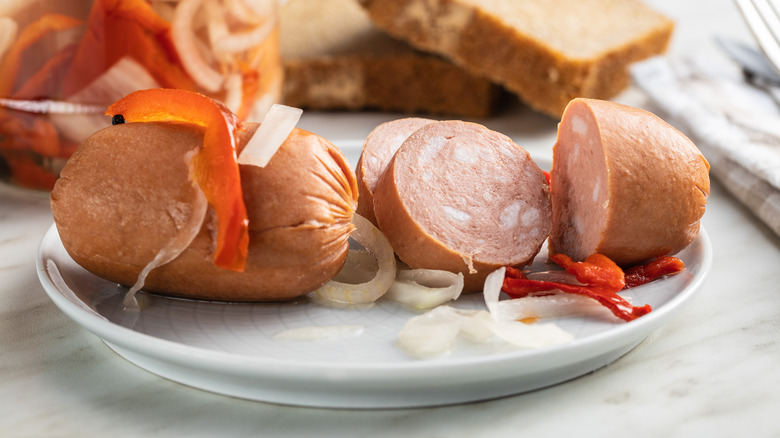These Are The Absolute Best Of Czechia's Iconic Beers (And Which Ones To Avoid)
U Zlatého Tygra (At the Golden Tiger) in Prague was once the favorite boozer of the beloved Czech writer Bohumil Hrabal. On the wall is a photo of the author enjoying a few beers with former presidents Václav Havel and Bill Clinton during the latter's visit to the capital in 1994. In other words, when the American Chief Executive was in town, his Czech hosts did what they do best: They took their guest to the pub.
It is hard to overstate how integral beer is to Czech culture. Czechs have been brewing quality hops since at least the 11th century, and Czechia's iconic beers are their greatest pride and joy. It's an often-quoted statistic that the Czechs drink more beer per capita than any other country in the world, and their brews are simultaneously the glue that binds the nation and the lubricant that greases the wheels of any social situation.
However, there are some signs that Czech drinking culture is changing. Recent reports reveal that Czechs are consuming less beer than ever before, coinciding with fears that a half-liter in Prague will soon top 100 CZK (around $4.20), an astronomical price that seemed unthinkable a few years ago. For now, beer is still king, and prices are relatively low for travelers on a budget. Visitors may be surprised by the sheer range of quality brews available, although there are a few duds. Let's take a look at which beers to seek out and what to avoid.
What are the best Czech beers?
The best place to start is with Pilsner Urquell and Budvar (Budweiser), Czechia's most famous brands, and the standard by which all others are measured. Established in 1842, the former's historic brewery in Plzeň is relatively young (the first was built in 1118), but its crisp bottom-fermented beer was the first of the pilsner lagers now popular worldwide. While you should consider a beer tour to taste it from the source, the best place to drink is an old-fashioned beer hall like U Zlatého Tygra. Despite its superstar status, however, it is possible to get a bad Pilsner — not every pub and restaurant treats the beer with proper reverence. Ideally, you want to see a professional tapster wearing a leather apron diligently pouring half-liters with a clean golden color and a towering foamy head.
The Budějovický Budvar brewery in the South Bohemian town of České Budějovice opened for business in 1895, and a long-standing dispute over the trademark "Budweiser" has been a contentious issue for over a century. Cans and bottles of the beer now proudly state: "Owned by the Czech Republic." At its best, Budvar is just as exquisitely clean and refreshing as its more revered rival and substantially tastier than its American namesake. If you're in Prague, one of the best places to get a fresh jar is U Medvídků (At the Little Bears), a beer hall and brewery dating back to the 15th century.
Other Czech beers you should try
Pilsner Urquell and Budvar are the premium options, but there are also plenty of great mid-range Czech beers available. Worth checking out are Radegast and Svijany, two pilsners with a robust and more bitter taste; and Bernard, a more dense and slightly cloudy brew. Brands like Kozel, Gambrinus, and Staropramen are cheap fridge-fillers ready for a grateful glug after a hard day or while relaxing in front of the TV. They're less celebrated but still very drinkable and equally enjoyable on tap at the pub without having to worry about appreciating them too much. Bridging the gap between these brews and the big guns are quality offerings from Poutnik, Polička, Chotěboř, and Hauskrecht. The latter two are relatively new breweries, established in 2009 and 2014 respectively.
Craft beers from independent microbreweries have become increasingly popular over the past decade, and many stylish modern pubs will carry at least one beer from hip, up-and-coming brewmeisters. Ones to look out for include Kocour, Zichovec, Matuška, and Sibeeria, all of which come with striking labels aimed at a discerning young crowd. Lager-type pilsners are still ubiquitous, however. For many Czechs and expats, drinking beer is a social activity often drawn out over the course of an evening with several half-liters to accompany the lively conversation. The beer is so good you might even want to bathe in it, and you can do exactly that in the spa town of Karlovy Vary!
Czech beers you should probably avoid
Czechia has many excellent beers, but they're not all winners. One of the least well-regarded by locals and visitors alike is Starobrno from the country's second city, Brno. It's a proud place with a fine historic brewery, but even more selective Brňáci will swerve a pub with a Starobrno sign above the door. It's fine enough when served fresh from a tank, but it is generally synonymous with cheap boozers, where it often tastes like dirty pipes. The only time everyone in the city drinks it is at Easter time when the brewery celebrates by churning out a green version. It's basically the same thing, just slightly sweeter, thanks to the added food coloring.
Other very mediocre brands include Braník, Březňák, Holba, Krušovice, and Zlatopramen. They're still not terrible compared to some mass-produced international lagers like Carling and Foster's, but the pubs carrying them tend to be dreary old-fashioned places. Save your drinking time by heading straight to the good stuff.
One thing you should definitely avoid is buying beer in liter plastic bottles. It might seem like a convenient and cost-effective choice when going on a picnic or trip to the countryside, but beer often goes stale when stored in plastic. If you do dabble in this range, at least steer clear of bottom-end brands like Argus and Deep, found lurking in Lidl supermarket beer aisles — they taste like the dregs from a pub drip tray.
Czech pub etiquette
Visiting a Czech pub is a casual and chatty affair, even if the service can be a little abrupt in more old-school places. Just grab a table and wait for someone to come over — you don't order at the bar like in America or the U.K. Don't be afraid to join another group if it's busy, although you should ask if a space is free before sitting down.
Your server will usually mark your order on a slip of paper and tally up at the end. In traditional pubs, they may keep bringing beers until you tell them to stop. When the beer arrives, it will likely have a big, frothy head. Don't worry, you're not getting ripped off — a good clean head indicates a quality brew. Asking for a top-up is a big no-no.
Toasting your table-mate is part of the pub ritual. A friendly "Na zdraví" (to your health) is sufficient with strangers, but you should also make eye contact while clinking glasses with friends. It's not essential, but locals often briefly tap the bottom of their beer glass on the table before drinking. Once you're done, your server will ask if you are paying separately (zvlášť) or together (dohromady). Try to avoid getting stuck with the bill at the end if you are in a group. People sometimes lose track of how many beers they've had, and the last person to pay is expected to pick up any leftovers on the tab.
Czech beer snacks
Drinking beer in Czechia can be hungry work, and many pubs will offer classic pub snacks to soak up the alcohol. Perhaps the most common are two pickled offerings — Nakládaný hermelín and Utopenec. The first is a soft cheese similar to brie marinaded in oil and spices. Utopenec translates to "Drowned Man," chunky sausages that have been soaking in vinegar. Both are often served with dark bread, onions, and mild goat horn chili peppers (kozí rohy).
One offbeat delicacy for adventurous foodies is Olomoucké tvarůžky, a soft curd-like cheese that gives off a pungent odor not unlike smelly feet. You'll often see it sitting out at room temperature in beer halls, served on bread with raw onions and a sprinkling of paprika. The spice also features heavily as the coating for a South Moravian favorite called Nivové koule, blue cheese balls pinned to a disc of bread roll along with a slice of pickle or other ingredients. Topinka is fried bread, sometimes served with sides, but most often rubbed vigorously with raw garlic before eating.
If you're supping outdoors, hot snacks often take center stage. Greasy Klobásy sausages are a staple of soccer matches, grill-outs, and public events. A big platter of chicken or pork Řízek (schnitzel) is a common sight at large gatherings — just grab one with a napkin. These snacks might not be the healthiest options, but they sure go well with a cold Czech beer. Na zdraví!

